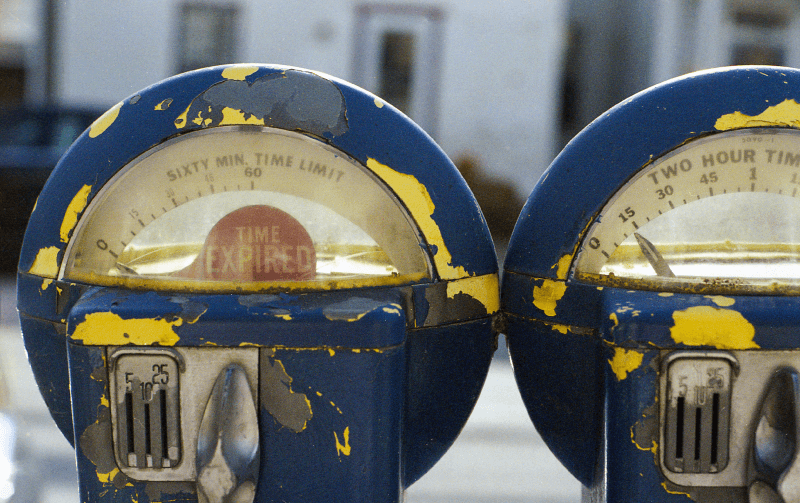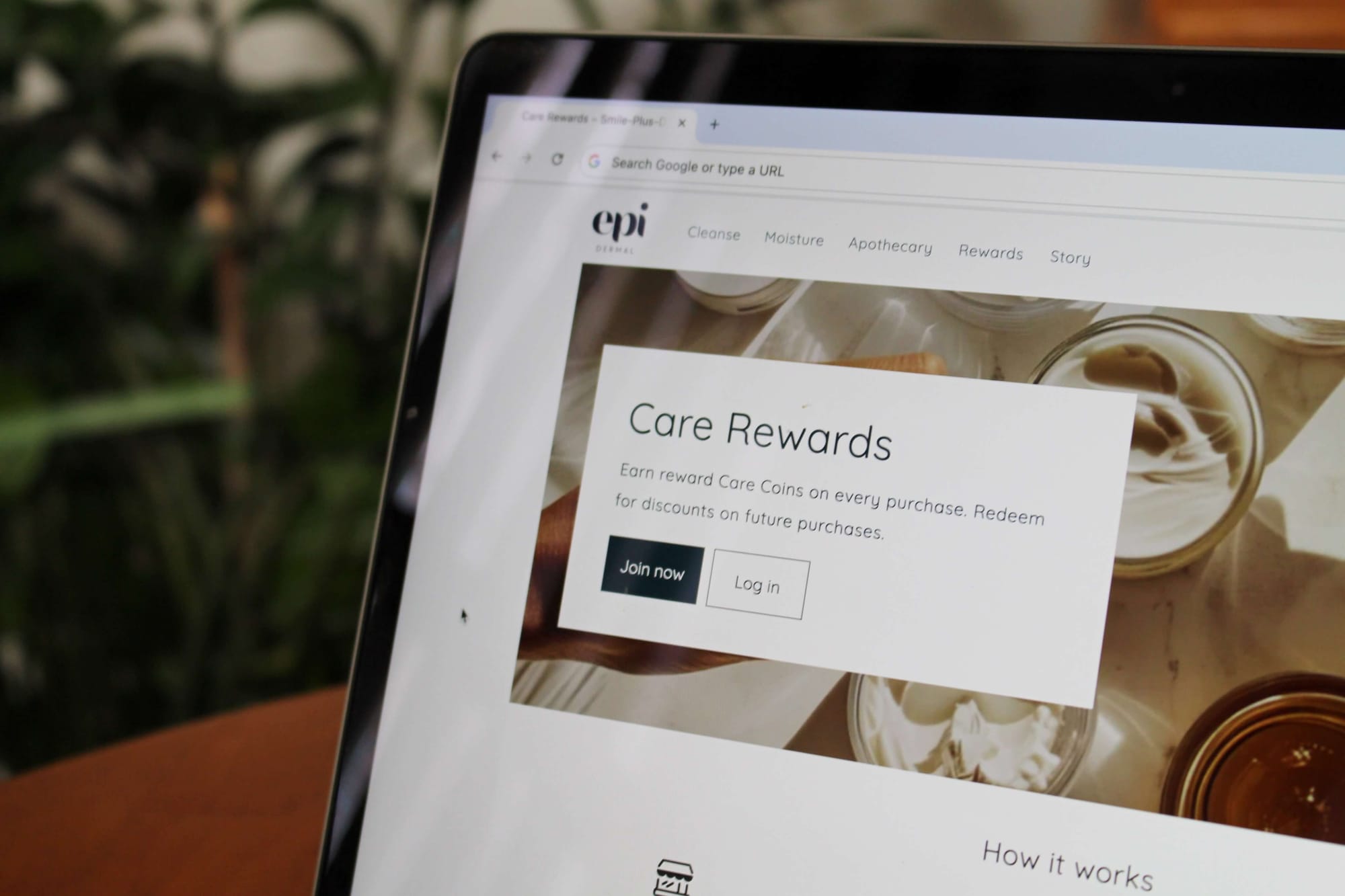“Treat others the way you want to be treated.”
We’ve all heard this golden rule before, and we’re all aware of the impact that courtesy can have on someone’s day. However, we’ve also all been in situations where an individual or business didn’t give us the courtesy we expected. Whether it was a passerby who didn’t hold the door for you or a negative experience with a retailer, impoliteness leaves a bad taste in everyone’s mouth. That being said, have you ever thought about how your customers might feel about your brand experience? More importantly, have you ever wondered if your customers feel this way about your rewards program?
All too often, rewards programs are designed for the benefit of the retailer with little thought left to what customers may be looking for in exchange for their loyalty. This is backwards thinking. Your business needs these customers to view it as valuable, and your rewards program should be designed in a way that truly thanks them for their support.
Whether you are new to the rewards program sphere or you’ve run one for years, these are five rules you can measure against your strategy to make sure your customers feel appreciated!
Rule #1 - Explain Your Rewards Program Well
Few things will discourage participation in your rewards program more than unclear program rules. If your customers aren’t sure of how to earn points for their actions (or how and what they can redeem these points for), you’ve failed to clearly communicate the value of your program.
Similarly, customers can’t follow instructions they aren’t given. Your customers’ participation hinges on your ability to outline the ways they can earn and redeem points as members of your rewards program. Without this clarification, you could end up with disengaged program members or, at the very least, a limited number of people who sign up for your program in the first place!
As a customer, one of the first things I look for in any rewards program is an explainer page. Explainer pages are the most effective way to clarify how your programs functions; including what’s in it for members, how they can earn points, and how many points they’ll need to redeem a reward. By the time a customer has finished reading your explainer page, they should be fully equipped to participate in your rewards program.
Wild Poppies, an Auckland-based flower delivery company, has mastered the art of the explainer page. Using a clear “REWARDS” tab in their navigation bar, customers can easily find a fully branded explainer page that clearly communicates the value of their rewards program.
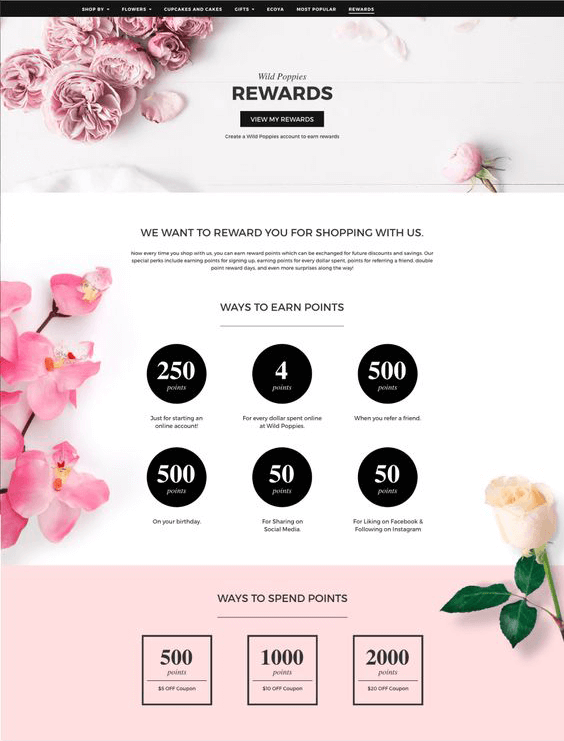
Using simple visuals, the Wild Poppies explainer page displays the ways in which customers can earn points and how they can be redeemed for rewards. Scrolling down, shoppers can also find details about program referrals and a helpful FAQ section that addresses any questions customers may still have.
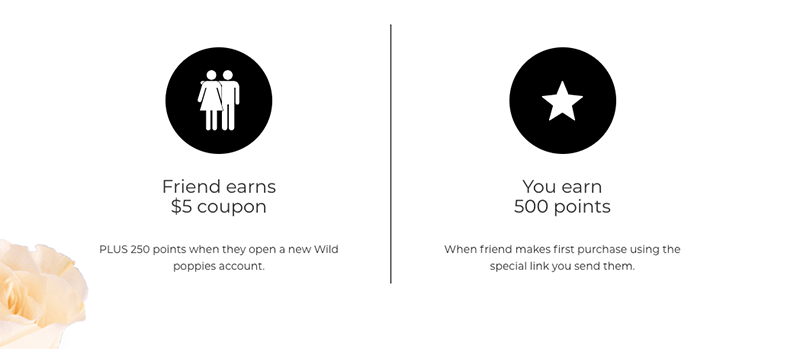
It’s clear that the designer of this rewards program considered any and all questions a customer may have, and created the explainer page with these concerns in mind. After a quick glance at the Wild Poppies explainer page, I feel fully equipped to participate in this program.
Rule #2 - Offer Rewards Customers Are Interested In
Have you ever been excited to join a rewards program, only to discover that the rewards you could earn aren’t all that great? It seems that a lot of brands advertise rewards they assume their customers want without actually asking them what they’d like to earn.
Before settling on the kinds of rewards you’d like to offer, there are a couple of things you should consider:
- What’s the average “stage of life” of your key customer demographic?
- What does your customers’ behavior look like?
First, determining what stage your customers are in with your business is important in choosing rewards that will benefit them the most. For example, a new customer is more likely to value a discount or coupon toward their future purchases, while a customer who has been shopping with you for a while may value a free product instead. Not every customer will value the same rewards, and the length of time a customer has shopped with you will impact their preferences.
In addition to life cycle stage, the customer behavior you’ve observed in the past can also inform the rewards you choose to offer. I am a great example of this at work. I often open emails from Sephora when I know the brand is offering a discount or promotion on tarte Cosmetics products. This repeat behavior is extremely helpful information for Sephora. Based on how I’ve engaged in the past, they know that this is a brand I’m interested in, and can cater the rewards they offer to reflect this type of preference!
At the end of the day, if you aren’t sure whether or not you’ve chosen the best possible rewards for your customers, ask them! It doesn’t hurt to request feedback from your customers, and they will appreciate your effort to make sure their voice has been heard. Sephora often looks to their Beauty Insider community for feedback on potential rewards.
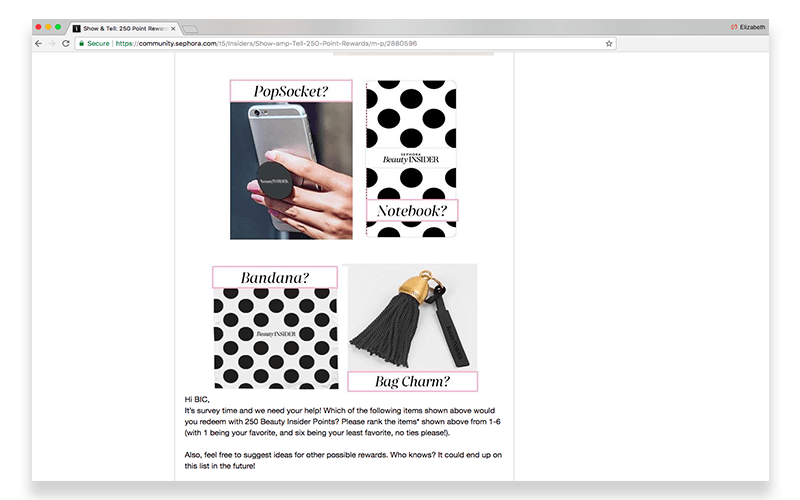
A simple post to the website discussion board invited program members to weigh in on the rewards they’re most interested in, and the result is win-win: a program with active members, and customers who feel satisfied and valued!
Rule #3 - Make Rewards Attainable
Offering rewards for loyalty and then making redemption unattainable is like leashing a dog with a bowl of food just out of reach - cruel and heartless!
Although that might be a tad strong, it does accurately illustrate another common rewards program problem: unattainable rewards. While the promise of rewards may encourage customers to keep spending, if you don’t follow through shoppers will soon realize that your intent wasn’t to thank them at all — it was simply to keep them shopping. This tactic may seem attractive in boosting your sales, but it will do your brand more harm than good in the long run.
If you are considering the launch of a rewards program, make sure your intentions are honorable. While a positive impact on sales, AOV and CLV can be byproducts of this retention tool, your first motive should be to delight your customers.
A brand that ensures rewards are always within reach is Dominos Pizza. The restaurant chain’s rewards program, “Piece of the Pie”, offers customers 10 points per order of $10 or more, and rewards customers with a free medium pizza at 60 points. That means every 6th pizza is free!
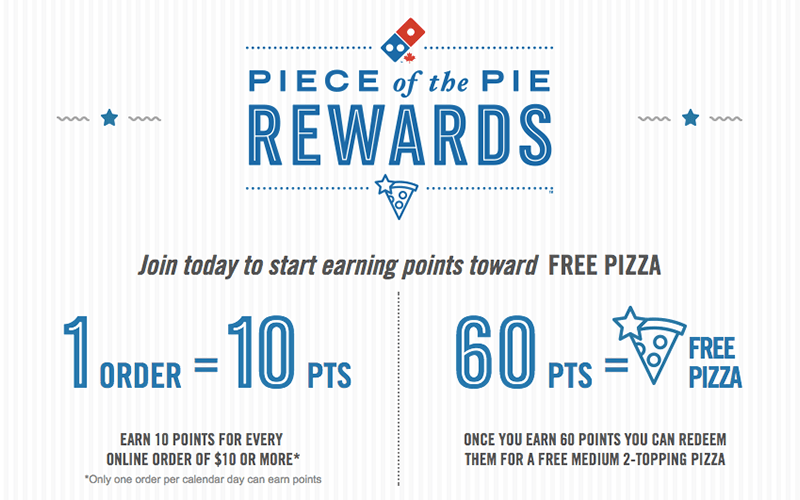
Since there are $3 billion pizzas sold in the US each year and industry switching-costs are low, Dominos knows that a points program is the perfect way to retain pizza lovers, especially if free pizza is on the horizon!
The moral of the story is, don’t dangle rewards in front of your customers with the intention of making sure that few will reach them. Like Piece of the Pie rewards, your program should be designed to actually provide value to customers that shop with you regularly.
Rule #4 - Make It Personal
It’s no secret that customers love customized experiences. In fact, a study by Accenture found that 75% of customers are more likely to shop with brands that call them by name and recommend products based on their unique needs. With more access to customer data than ever before, brands have the potential to create a completely personalized experience for all of their rewards program members.
Whether you’re addressing them by name or making personalized recommendations, your customers will appreciate the time you’ve taken to ensure they feel heard, valued, and taken care of.
Not sure how to leverage customer data well? The PC Plus rewards program (soon to become PC Optimum) has personalization down to a T. Their customized emails call members by name, share their points balance, and updates customers on their progress towards their next reward.
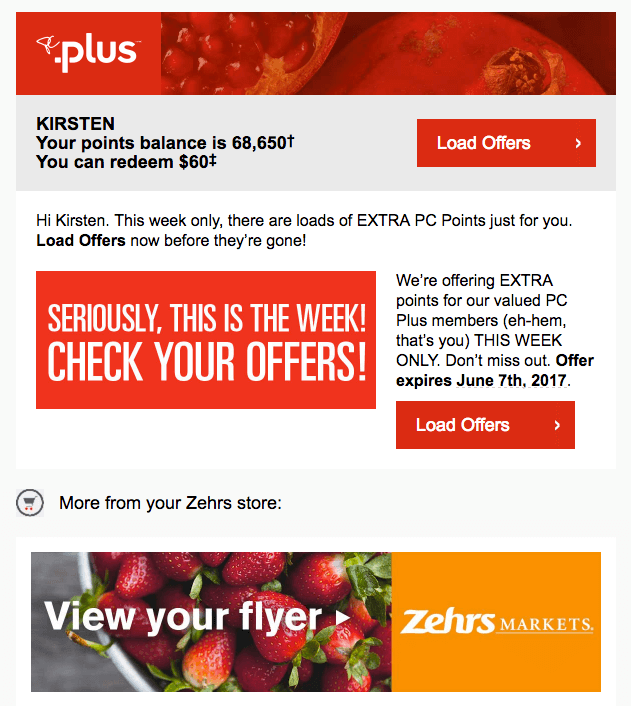
In addition to individually catered emails, President’s Choice also sends program members personalized grocery recommendations each week. Based on past customer behavior, these recommendations provide incentive for members to shop with President’s Choice and earn points on the products they already love. Talk about presidential treatment!
Although it’s easy for customers to feel like another number in your database, but they shouldn’t have to. Small gestures go a long way, and 63% of customers think more highly of brands who make personalized, relevant content a priority in their communications.
Using your shoppers’ customer data, you can create a program experience that offers value beyond rewards.
Rule #5 - Clearly Communicate Point Expiration Policies
Point expiration can be a sore spot for many customers. Having stuck with your brand long enough to accumulate a mountain of points, the last thing a customer wants is to have their hard-earned points disappear at the drop of a hat.
While there are different views on whether or not point expiration should be enforced (and different approaches your brand can take), one rule is universal: clearly communicate your expiration policy. There are a few ways this can be done:
- On your brand’s explainer page
- In an email campaign
- On your customer’s account page (web or mobile)
One of the simplest ways to ensure your customers know your policy is to share this information on your explainer page. As previously mentioned, your explainer page should be a one-stop-shop for all of your program details, and point expiration shouldn’t be buried in the fine print. Since your program is designed to retain loyal customers, expiring your best customers’ points without telling them when or why it will happen is a surefire way to act against the program’s intention.
To keep program members in the know about the status of their points, it’s also helpful to include information about points expiry in email campaigns and customer accounts. You can do this by sending an email to customers who haven’t redeemed in a while, reminding them of their points balance and encouraging them to come back and take advantage of them.
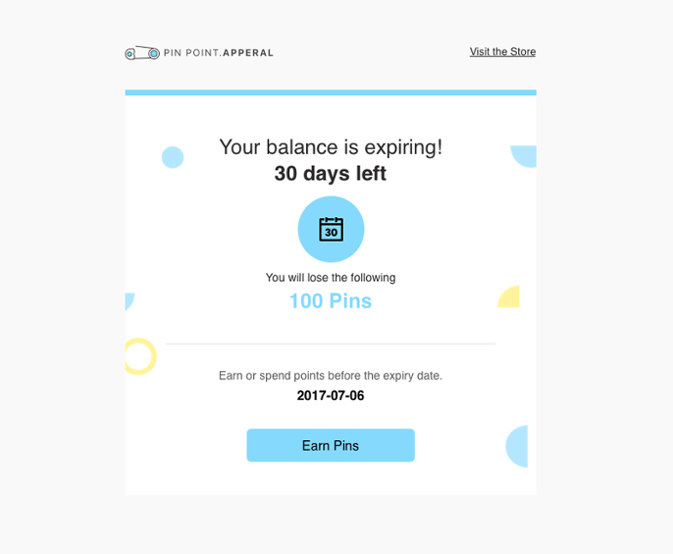
This simple practice can also be incorporated into a customer’s account page. To show customers what they might be missing, simply display their points balance at login and clearly communicate the time they have left to act before it’s too late.
The choice of whether or not your customer’s points should be set to expire is up to you. Taking the time to educate your customers on your policy, however, should be non-negotiable. Treat your customers with the respect they deserve!
Mind Your P's and Q's
Your rewards program plays an essential role in your customer experience with your brand. Don’t throw it all away by failing to cross your t’s and dot your i’s — take care to make sure your program treats customers fairly. If you follow the rules, your program will do exactly what it was intended to... show your customers that you value everything they’ve done to take your business this far!





